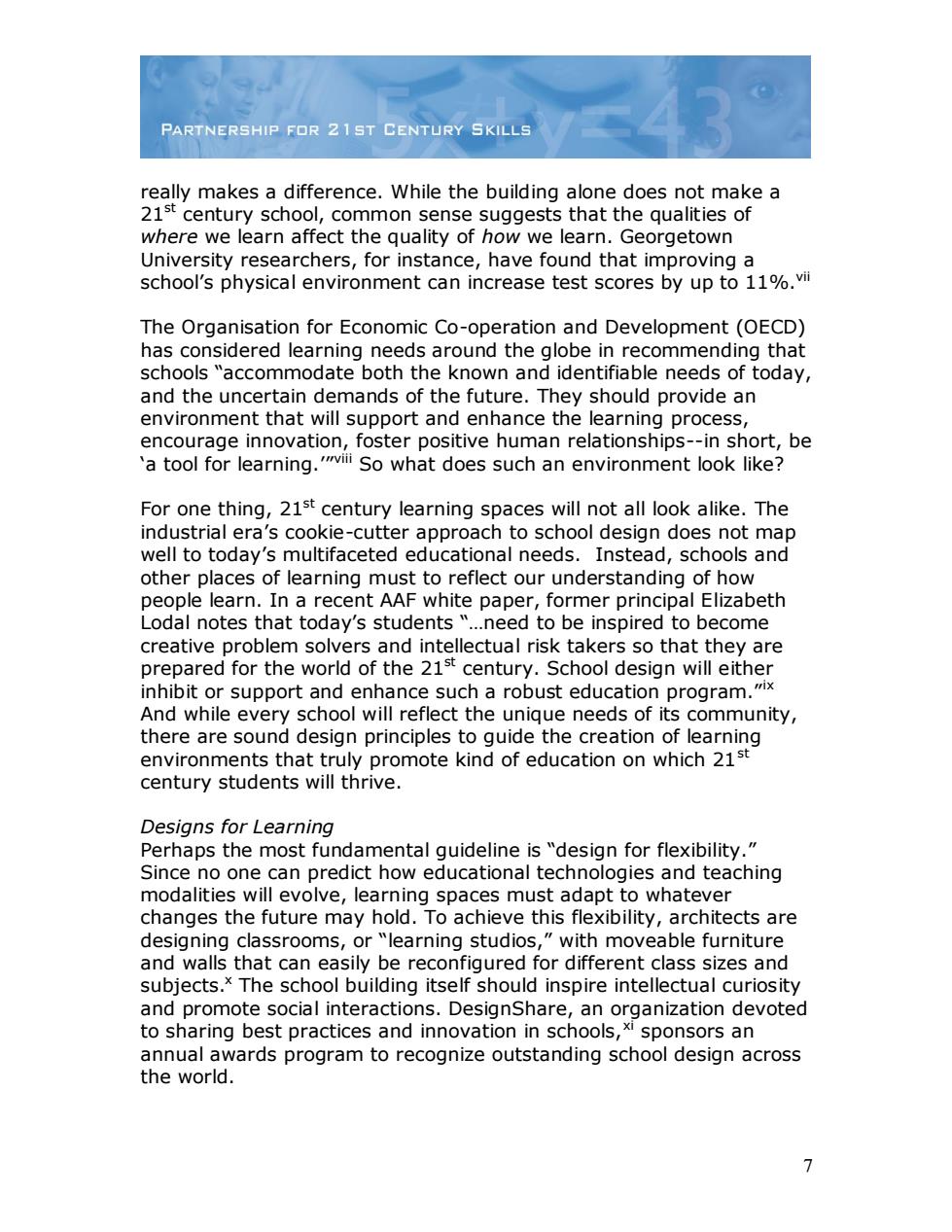正在加载图片...

PARTNERSHIP FOR 21ST CENTURY SKILLS really makes a difference.While the building alone does not make a 21t centur common that the where we learn affect the quality of how we learn Georgetown University researchers,for instance,have found that improving a school's physical environment can increase test scores by up to 11%.vi The Organisation for Economic Co-operation and Development (OECD) "accommo odate both the wn and identifiable nee and the uncertain demands of the future.They should provide an environment that will support and enhance the learning process, encourage innovation,foster positive human relationships--in short,be 'a tool for learning."So what does such an environment look like? For one thing,21st century learning spaces will not all look alike.The industrial era's cookie-cutter approach to school design does not map well to today's multifaceted educational needs.Instead,schools and other places of learning must to reflect our understanding of how aper.for al Elizabeth ay's stude te ed to be ed to become creative problem solvers and intellectual risk takers so that they are prepared for the world of the 21st century.School design will either inhibit or support and enhance such a robust education program."ix And while every school will reflect the unique needs of its community there are sound design principles to guide the c environmen hat promote kind of century students will thrive. Designs for Learning Perhaps the most fundamental auideline is desian for flexibility. Since no one can predict how educational technologies and teaching olve lea spaces must adapt to whateve ve this flexibility,architects are designing classrooms,or "learning studios,"with moveable furniture and walls that can easily be reconfigured for different class sizes and subjects.*The school building itself should inspire intellectual curiosity and promote social interactions.DesignShare,an organization devoted to sharir ing best t practices and i innovation ols, sponso ors a an annual awards program to recognize outstanding school design across the world. 7 7 really makes a difference. While the building alone does not make a 21st century school, common sense suggests that the qualities of where we learn affect the quality of how we learn. Georgetown University researchers, for instance, have found that improving a school‟s physical environment can increase test scores by up to 11%.vii The Organisation for Economic Co-operation and Development (OECD) has considered learning needs around the globe in recommending that schools “accommodate both the known and identifiable needs of today, and the uncertain demands of the future. They should provide an environment that will support and enhance the learning process, encourage innovation, foster positive human relationships--in short, be „a tool for learning.‟” viii So what does such an environment look like? For one thing, 21st century learning spaces will not all look alike. The industrial era‟s cookie-cutter approach to school design does not map well to today‟s multifaceted educational needs. Instead, schools and other places of learning must to reflect our understanding of how people learn. In a recent AAF white paper, former principal Elizabeth Lodal notes that today‟s students “…need to be inspired to become creative problem solvers and intellectual risk takers so that they are prepared for the world of the 21st century. School design will either inhibit or support and enhance such a robust education program.”ix And while every school will reflect the unique needs of its community, there are sound design principles to guide the creation of learning environments that truly promote kind of education on which 21st century students will thrive. Designs for Learning Perhaps the most fundamental guideline is “design for flexibility.” Since no one can predict how educational technologies and teaching modalities will evolve, learning spaces must adapt to whatever changes the future may hold. To achieve this flexibility, architects are designing classrooms, or “learning studios,” with moveable furniture and walls that can easily be reconfigured for different class sizes and subjects.x The school building itself should inspire intellectual curiosity and promote social interactions. DesignShare, an organization devoted to sharing best practices and innovation in schools,xi sponsors an annual awards program to recognize outstanding school design across the world